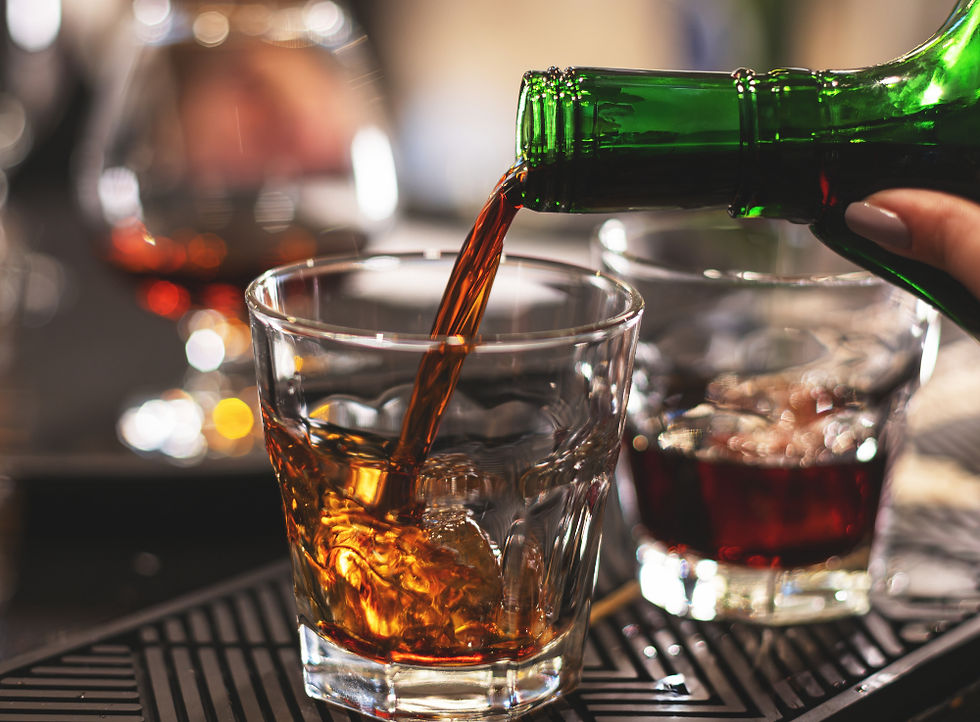Navigating Change in the Whiskey and Beer Markets
- Vik F.

- Nov 2, 2024
- 4 min read
The U.S. whiskey and beer markets have seen impressive growth over the years, yet both categories are now facing a period of recalibration. With shifts in consumer preferences, an increasingly competitive landscape, and economic factors shaping spending habits, these industries are navigating changes that will define their future.

The recent downturn in the beer market has been particularly stark. According to the Beverage Information Group’s 2024 Industry Overview, beer consumption in the U.S. dropped by 4.4% in 2023, with the industry volume now at 2.68 billion cases. Only two segments—imported beers and flavored malt beverages (FMBs)—showed growth, and it wasn’t enough to counterbalance the declines in domestic beer categories. Even long-time leader Bud Light lost its number one spot, with Modelo Especial now holding the top position. This shift in rank, driven by changing consumer preferences and a major brand boycott, illustrates how quickly brand loyalty can waver in today’s market.
Craft beer, once the darling of the industry, is experiencing a slowdown of its own. The once-booming craft segment has been impacted by market saturation and a shift in consumer habits. As the number of breweries has skyrocketed, many consumers are moving away from experimental or high-priced brews and opting instead for either familiar, large-scale craft brands or classic, affordable options. The price increase of craft beers, due to higher production and supply chain costs, has made cocktails or other drinks more appealing to cost-conscious drinkers. Many consumers now do a value assessment when choosing a drink, leading them to seek out choices that offer more bang for their buck.
Some bars and breweries are adapting by diversifying their menus. Venues like Treadwell Park in New York are incorporating alternative beverage options and carrying unique beers that stand out from traditional offerings. According to Treadwell Park’s general manager, Katherine Benecke, success often comes from conveying a brand’s story and commitment to quality. Consumers today value transparency and seek brands with clear identities, helping build a loyal customer base.
Despite challenges, the craft beer industry continues to make a strong local impact. With a retail value of $22 billion, craft beer remains an essential local job provider, with breweries within a short drive of most American households. Smaller breweries, like Talea in New York and Back Home Beer, which is led by Iranian and women founders, highlight the diversity and local appeal that keep consumers engaged in the craft sector, especially among those who favor local, independent brands.
In the non-alcoholic (NA) segment, beer is experiencing a surge. Brands like Athletic Brewing Co., which holds over 19% of the NA beer market share, are leading this category’s growth as more consumers seek alternatives that align with a balanced lifestyle. This interest in NA options is evident not only in specialized bars like Ocean Beach Cafe but also in traditional liquor stores, where NA offerings have increased significantly since the pandemic. These NA options are meeting the demands of a new audience focused on wellness while maintaining their connection to the beer market.
Meanwhile, whiskey faces its own set of hurdles and transformations. American whiskey saw remarkable growth during the pandemic as consumers expanded their home bar setups and became increasingly knowledgeable about whiskey. However, whiskey sales have now leveled off as consumers become more selective and spending patterns change. Some high-end bottles, priced between $80 and $100, have been hit hardest, while sought-after bottles still command attention and even create waiting lists. Whiskey fans are shifting toward “quality over quantity,” favoring unique small-batch bottles and new flavors while staying within more approachable price ranges.
Innovation in whiskey, though essential, has reached a saturation point. Industry experts are beginning to draw comparisons between whiskey’s current situation and the craft beer boom of the past, where rapid product innovation and market saturation eventually led to consumer fatigue. While some whiskey brands continue to experiment with flavors and production techniques to stand out on shelves, there’s now a recognition that constant innovation may not be sustainable. Instead, whiskey makers are focusing on offering a range of quality products that appeal to the discerning tastes of today’s educated consumers.
This shift in consumer sophistication has elevated the on-premise experience for whiskey lovers. High-end bars, restaurants, and even hotels like Hotel ZaZa in Dallas are offering curated whiskey experiences that allow patrons to explore a brand’s full portfolio or sample rare releases. These exclusive tasting opportunities give whiskey drinkers a way to connect more deeply with their chosen spirits, enriching the experience with insight into the craft behind each bottle. As Alex Guerra of Breakwater Hospitality Group notes, consumers today approach whiskey with greater intention, seeking value in both taste and the story behind the bottle.
Looking ahead, both the whiskey and beer industries are navigating a period of maturation. Craft beer’s challenges point to a natural adjustment after years of unchecked growth, while whiskey’s slowdown reflects the more thoughtful approach consumers are taking with their purchases. Despite these adjustments, both sectors are likely to endure, fueled by a foundation of consumer loyalty, local impact, and the lasting appeal of premium experiences. As tastes continue to evolve, the industry’s ability to adapt while maintaining quality will be crucial in shaping the future of both beer and whiskey.
With these shifts, the emphasis on authenticity, local connection, and well-crafted products has become more important than ever. Beer and whiskey brands alike are recognizing the value of staying true to their roots, prioritizing quality over quantity, and connecting with consumers on a meaningful level. Whether it’s through a carefully brewed local beer or a finely aged small-batch whiskey, the future of these categories lies in understanding and meeting the nuanced needs of today’s discerning drinkers.
Sources:

















Comments